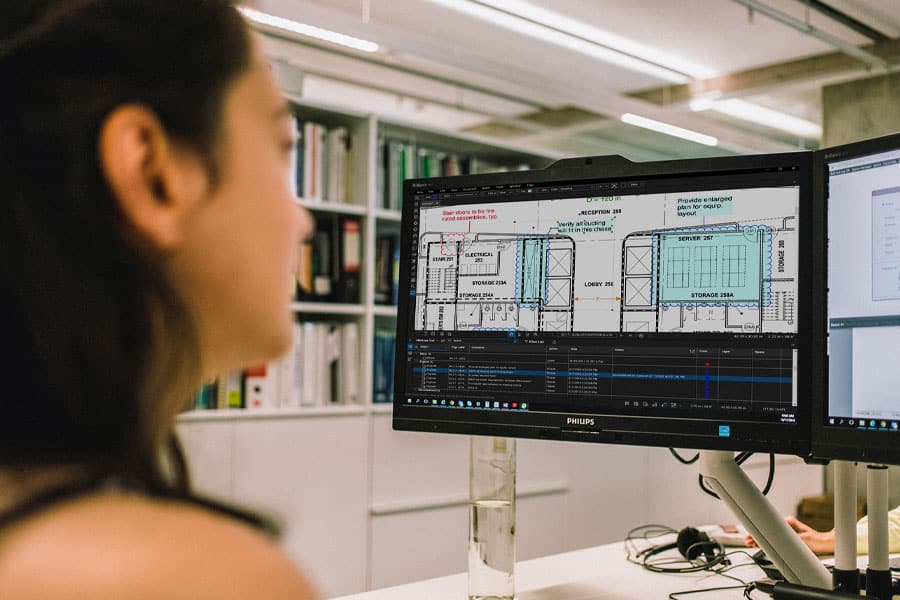Managing public sector construction projects
Delivering any built asset is an expensive and time-consuming endeavor.
Developers, designers and contractors are under considerable pressure to produce a result that will satisfy all stakeholders, from investors to occupiers and the larger community surrounding the building.
This assumes even more importance when overseeing public sector building projects, such as a school or local health care facility, given the pressures on the public purse and the need for a smooth delivery that is on time and within budget.
In the current economic climate, with building materials becoming more expensive and labour shortages pushing up employment costs, the need for accurate and dependable information, communication and drawings when starting a project is crucial.
Tools to work within time and budgetary constraints
Bluebeam helps public sector construction teams finish the job faster, featuring a series of highly customisable markup and collaboration tools that speed up reviews and improve communication.
With this in mind, Nick Erasmus, technical director with Real Data Systems, walks viewers through the benefits of using Bluebeam when working on design drawings and other documentation for a public sector development in a specially commissioned webinar.
What follows are some pointers from the session, which hopefully give a flavour of what Bluebeam’s public sector construction software can offer.
Custom profile capabilities
“Bluebeam features a default profile called Revu Advanced, which has the ability to create custom profiles, either via by department or reviewer,” Erasmus said. “In some cases it’s departmental; in others it’s discipline specific.”
Profiles and associated tools can be created and shared very easily across a whole organisation, Erasmus said, “so that everybody always uses the same markups and the same information, all the time. So it’s never, ever going to be trying to decipher someone’s handwriting again.”
Erasmus said Bluebeam’s reviewing and markup tools are “pretty much untouched in the industry.” Markups can be tracked, as can the history of a conversation around a change made to a design. Another important—and hugely helpful—element is that hyperlinks to other documents related to the project can be linked to markups.
Managing digital information across public sector construction projects is also more straightforward when using Bluebeam, according to Erasmus, with workflows rendered more streamlined.
Scale drawings accurately
Bluebeam helps with a variety of tasks, starting with ensuring a drawing is to scale. A submitted drawing should always be at the correct scale to be compliant, but Bluebeam can help a user confidently scale a drawing.
Once a drawing’s scale has been fixed, one can start with the review. “This is what sets Bluebeam apart,” Erasmus said. “You can create your own custom tools to specifically do tasks very quickly, for example to deal with issues around accessibility for patients in wheelchairs in a hospital corridor.”
“We need to know if these corridors comply to a certain standard in terms of wheelchair access,” Erasmus added. “We’ve pre-set up a tool that we can basically utilise very quickly by simply clicking on it, dragging it and placing it around the end of a corridor to make sure that a wheelchair will be able to turn around if required within a corridor.”
Construction management tools within Bluebeam also enable users to check how a project aligns with building regulations in each territory at the click of a button.
“A link dynamically takes us directly to a clause within the regulation,” Erasmus said. “No guessing has to happen. One is referencing the latest document that is set out in accordance with the regulations.”
Trackability makes life easier
Changes are often made to drawings as a project evolves. Changes made to a drawing using Bluebeam create an historic record, so new and old can be assessed, if required.
According to Erasmus, trackability within the markups list is very powerful, as is the communication around it. “It tracks everything that happens within our drawing environment … and carries the data that we want out of the drawing,” he added.
Once a drawing has met with everyone’s approval, it needs a stamp. If your document has many pages, you can apply a stamp to all pages with a specific tool.
“With one click and saying that you want to stamp across all 32 pages of a document, it will automatically take that stamp and will apply it to all 32 pages very quickly, rather than having to individually stamp each one,” Erasmus said.
Remote collaboration in real time
Bluebeam can be used by public sector construction teams anywhere in the world, at any time, through its capability for real-time collaboration, Studio Sessions.
Colleagues can collaborate remotely, according to Erasmus. “If I set up a Studio Session called the public sector webinar … a person joining this session at any given time means we can both mark up the same drawing in real time. You will see the same information as they do in real time,” he said.
Whether for private or public sector construction, collaboration, reliability, accuracy and ease of use are the cornerstones of Bluebeam.
To watch Erasmus’ webinar on the advantages of Bluebeam and what it can offer development teams, click here.
And to find out more about what Bluebeam can do for delivering projects in the public sector, click here.











